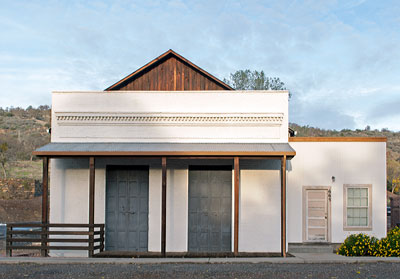National Register of Historic Places in Calaveras County
Honigsberger Store
665 O'Byrnes Ferry Road
Copperopolis
Built 1856
The Honigsberger Store is a simple one-story, rectangular, brick building with a false front. The brick is laid in a common bond pattern with a corbel table and dentils as a frieze near the top of the front façade. This distinctive Neoclassical brick commercial architectural style was popular in the California Mother Lode during the late 1850s and early 1860s. The use of brick, with simple dentil cornicing, relieving arches over the windows and doors, multi-paned sash windows, and glass and panel double doors with iron shutters reflect a period when simple well-constructed with iron shutters reflect a period when simple well-constructed brick commercial buildings lined the main streets of America.
The original low-pitched metal gable roof was replaced with one that was more steeply pitched sometime before 1905. The front and rear porches, missing since ca. 1905, have recently been replaced and are hung from the original metal brackets.
The building served as an important commercial enterprise in Copperopolis in the 1860s copper boom years, when its mines were the second most productive in the nation and provided copper for shell casings and munitions for the Union side in the Civil War.
From 1905 to 1929, it was the main warehouse for the Union and Calaveras Copper Companies, encompassing the period 1909-1929 when the reorganized company attempted to again bring mining in Copperopolis to an important scale. This effort was assisted by the need for copper for another war, this time for the United States in World War I.
The Honigsberger Store is one of three remaining brick structures in what was the original center of the community, fronting on the Plaza, and is located north of the Armory of the Copperopolis Light Guard and Reed's Store, both brick buildings constructed in the early 1860s. Other than the 1866 Congregational Church, there are no other buildings remaining of the more than sixty which were constructed during the initial copper boom.
Adapted from the NRHP nomination.

Mining camps started as clusters of tents and other makeshift shelters. If the mine was productive, wooden buildings were erected and a town was born.
Conflagrations were a recurring curse. Often entire town were repeatedly destroyed by fire. Stonemasons, especially Italian immigrants from Liguria, began building "fire proof" banks and stores of stone or brick with iron doors and iron window shutters to protect the contents from fire.
Many of these stone buildings survive. Some of them, such as the Butte Store, are the sole reminders of a lost mining town.
Some of these buildings are:
Butte Store in Amador County
Calabozo in Hornitos
Civil War Armory in Georgetown
Compere Store in Murphys
Downieville Museum in Downieville
Fountain & Tallman Soda Works in Placerville
Gamble Building in Big Oak Flat
Hirshfeldter Building in Downieville
Honigsberger Store in Copperopolis
Italian Store in Douglas Flat
Kohler Store in Washington
Mackerman & Company Building in Downieville
Masonic Lodge in Columbia
Masonic Lodge in Hornitos
Nevada Brewery in Nevada City
Nevada Theatre in Nevada City
Odd Fellows Hall in Big Oak Flat
Old Segale Building in Murphys
Old Stone Garage in Truckee
Plymouth Trading Post in Plymouth
Pearson Soda Works in Placerville
Sam Choy Store in Angels Camp
Stage Stop in La Grange
Valente Building in Murphys
Watts & Tannahill Company Store in Groveland
Wells Fargo Bank and Stage Stop in Georgetown
Wells Fargo Express in Chinese Camp
Wells Fargo Express in French Corral
Wells Fargo & Company in North San Juan

